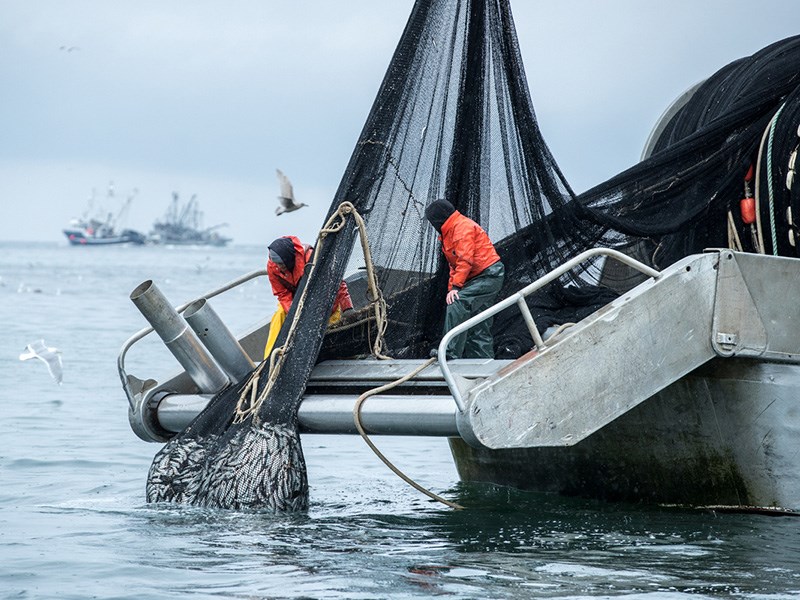Herring declines in the Strait of Georgia have caused conservation groups to call for an end to the annual fishery.
The call is supported by sports fishing advocate Sam Sansalone, owner of Powell River Outdoors, an outdoor specialty store.
“We fish the herring and I’m guessing we ship the roe overseas,” said Sansalone. “The rest apparently gets made into fish farm food. That’s basically why they do it.
“Is that more important than the big picture? The big picture is that herring is the food source for everything out there. Jurassic Park is out there and herring is going to feed the giant park. The whales are in trouble and things aren’t perfect.”
Conservancy Hornby Island and the Association for Denman Island Marine Stewards, headquartered at the epicenter of the remaining herring spawning grounds in the northern Gulf Islands, plus Sea Shepherd Conservation Society and Pacific Wild, are calling on the federal government to create a pacific herring recovery program for the Strait of Georgia and immediately close the fishery.
A media release from the groups stated that recently released data from the Fisheries and Oceans Canada (DFO) revealed the population biomass has dwindled from approximately 129,500 metric tonnes in 2016, to 85,700 tonnes in 2019, and is predicted to fall to 54,242 tonnes in 2020. This is a reduction of almost 60 per cent in four years, according to the conservation groups.
The release stated that the herring population in the Strait of Georgia has endured years of excessive quotas, based on overestimated biomass calculated using a post-industrial fishing baseline. According to DFO regional herring officer Victoria Postlethwaite, the 2019 quota was set based on a predicted return of 122,291 tonnes, but only 85,700 tonnes returned.
“Fisheries ended up catching 25 per cent of the population, exceeding the 20 per cent harvest quota once again,” the release stated. “The four other herring populations in BC have already collapsed in recent years due to overfishing.”
Sansalone said closure of the herring fishery would affect people’s livelihoods.
“But at the end of the day, is it really worth harvesting this roe for people overseas to enjoy?” he added. “Is that more important than the big picture: the ecosystem?”
For those displaced by a herring fishery closure, a solution might be for the federal government to buy out their licences, said Sansalone. He added that in 1983, science said there was a great herring fishery in Powell River.
“I’m guessing they sent 80 to 90 seine boats to Powell River because there were great stocks of herring, lots to fish, and that’s what the science said,” said Sansalone. “The facts said there hasn’t been that quantity of herring after. The science said there was a healthy population of herring in Powell River, and if you talk to people who were here, you had herring so thick in the strait you could scoop it up in buckets. Here we are in 2019 with all of this technology and these brainiacs running around, and it’s basically fished right out.
“My opinion is that it’s not worth taking the roe for what it is going to cause. No herring, no fish. It’s that simple.”
According to DFO communications advisor Michelle Rainer, conservation is the department’s first priority in the management of Strait of Georgia herring fisheries.
“Every year, DFO conducts scientific surveys for each of the five major Pacific herring stock areas; these scientific surveys, along with biological sampling, inform a yearly peer-reviewed scientific stock assessment with up-to-date advice on the status of all five major stocks,” said Rainer in an email to the Peak. “DFO also works with indigenous communities and harvesters in the Strait of Georgia to better understand herring distribution, spawning dynamics and traditional harvest areas. This work underpins the department’s decisions on seasonal harvest opportunities, which are designed to ensure there are enough herring left to spawn and sustain the stock and fisheries into the future.
“Pacific herring forecasts are highly uncertain because factors such as environmental conditions and predation can vary from year to year. The science advice includes a range of harvest options.”
Sansalone said it appears herring stocks are slowly recovering because it hasn’t been fished commercially here. If the herring is left alone, perhaps the spawn will come back on the coast, he added.
“We’ve had a few spawns on the coast over the past 20 years,” said Sansalone. “The numbers are better. I’m guessing in 2019 there were more whales spotted than were hanging around in the last 10 years combined. The ecosystem is full of life out there.”
He added that recent angling reports show winter springs have been coming in at 12 or 13 pounds. He is guessing it is because of a greater abundance of herring.
“It’s not an easy fix, but a grade five kid could tell you herring is the food source that feeds pretty well everything the whales would end up eating,” said Sansalone.
Rainer said that for the 2018/2019 fishing season, a target harvest rate of 20 per cent was provided for commercial fisheries in the Strait of Georgia. For 2019, the forecasted range for the Strait of Georgia was 67,000 to 221,400 metric tonnes and the median was 122,921 tonnes.
The most recent data from the scientific surveys indicate that in fact, spawning biomass in the Strait of Georgia was closer to the bottom half of the forecast range, resulting in a harvest rate of 25 per cent in 2019.
“DFO has tested and implemented a harvest strategy that has a high probability of conserving the stock over the long term, despite this uncertainty associated with the variability of the stock,” said Rainer. “Changes to the environment may create additional challenges. Research is ongoing to understand these changes and DFO is working to adjust its management approaches where needed to respond to these new uncertainties.”



